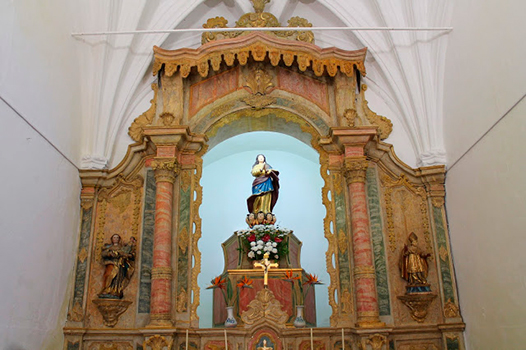 |
Initially called of Santa Maria de Aguiar, the Church of Nossa Senhora da Assunção (Our Lady of Assumption) de Aguiar was probably established between the 12th and the 13th century, but only appears mentioned in royal documentation in the 14th century.
In the 16th century the church was reformed but today only in the main chapel subsist Manueline traces, preceded by a round arch in granite composed by double colonnettes, with bases of pentagons and capitals decorated with vegetal motifs. The vault has ribs coming from prismatic corbels, forming gothic ogives whose cornerstones present naturalist motifs, angel’s heads and, on the central stone, a crown of thorns is visible.
In 1534 following an Episcopal visitation, the nave was re-covered with wooden beams and the façade’s porch was redone1. The humanist and collecting enthusiast André de Resende (1500-1573) was rector of this church and sponsored the building of a retable2, which cost 130000 Portuguese réis, being replaced by the current one already in the second half of the 18th century, supposedly during the priory of D. António Henriques de Sousa de Melo e Castro, around 1760.
The current rococo retable, decorated with polychrome wood carving, has two Corinthian columns, pelmet pediment and floral ornaments. In the middle is Nossa Senhora da Assunção and in the lateral pedestals Santa Ana and São Luís Bispo3. Of note is the representation of Santa Ana Mestra, 18th century, which shows a corporal disproportion, namely in the hand that perhaps had a book. The flexion of the leg, the folds of the mantle and the veil give this sculpture movement and dynamism. The composition stands on a base of clouds where a snake stands out.
The baptismal chapel, preceded by a barrel arch and pilasters, preserves a marble sink that probably does not correspond to the original commissioned in 1534 by Prior D. Martinho, following the visitation.
In the 18th century the initial volumes of the façade were destroyed and replaced by a granite portal and triangular pediment, from which emerge a stone cross, a spire and a masonry belfry, decorated with artistic graffitos, and two bells of bronze. The oldest, with the marked date of 1772, has a relief cross, the emblem of J.H.S and the symbols of the martyrdom of Jesus. In the 18th century intervention, the porch of the façade disappeared and the wooden struts were replaced by the current vault.
The exterior clock has a marble tombstone where it is said to have been inaugurated on 16th November 1958, being reverend Venceslau Gonçalves de Almeida Gil.
According to the Memória Paroquial (Local Parish Records) of the Parish of Aguiar, from 1758, the church’s main altar was at that time already dedicated to Nossa Senhora da Assunção (Our Lady of Assumption); the second to Nossa Senhora do Rosário (Our Lady of the Rosary); and the third to the Almas Santas (Blessed Souls). The document also mentions the brotherhoods of the Santíssimo (Most Holy), of the Rosário (Rosary), of the Almas (Souls) and of the Senhor Jesus das Chagas (Lord Jesus of the Wounds). Túlio Espanca, in addition to those mentioned above, also adds the brotherhoods of Santo António (Saint Anthony), of Senhora da Assunção (Our Lady of Assumption); and of Senhora das Candeias (Our Lady of Candeias).
In 2005, the company Memoriae Tradere did some works on the altarpiece that, when partially dismantled, confirmed the existence of mural painting in poor state of conservation, and that remains hidden. The intervention consisted in the removal of enamel paints, applying traditional preparations and also a restoration of the structure and decorative elements.
The side chapels dedicated to Nossa Senhora das Candeias (Our Lady of Candeias)and to Cristo Crucificado (Crucified Christ) have sculptural sets from the 17th-18th centuries, whose iconographic attributions, according to Artur Goulart Melo Borges, refer in the first chapel to the representations of Nossa Senhora do Rosário (Our Lady of the Rosary), of Santo António (Saint Anthony) and São Bento , and in the second chapel the image of Cristo Crucificado (Christ Crucified) is followed by São Sebastião (St. Sebastian) and São José (St. Joseph).
REFERENCES
BORGES, Artur Goulart Melo Coord., Arte Sacra em Viana do Alentejo- Inventário artístico da Arquidiocese de Évora, Évora, Fundação Eugénio de Almeida,2008.
ESPANCA, Túlio, Inventário Artístico de Portugal. Distrito de Évora. Concelhos de Alandroal, Borba, Mourão, Portel, Redondo, Reguengos de Monsaraz, Viana do Alentejo e Vila Viçosa, Vol. 1, Lisboa, Academia Nacional de Belas Artes, 1978.
1 - A.N: It didn’t resist until our days.
2 - A.N.: Of unknown whereabouts.
3 - A.N.: Túlio Espanca mentions an image of Nossa Senhora das Candeias with a baby in a state of advanced degradation but that today is not in the church for unknown reasons.

 Abrir Lista
Abrir Lista MUNICÍPIO DE VIANA DO ALENTEJO
MUNICÍPIO DE VIANA DO ALENTEJO